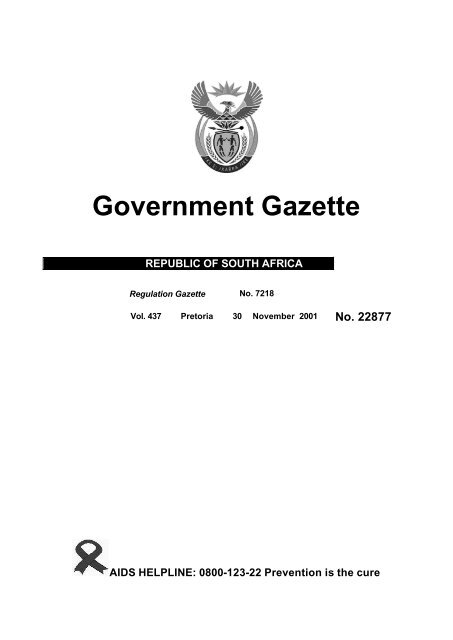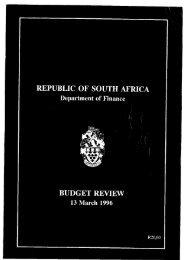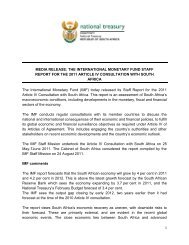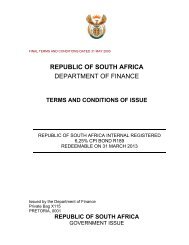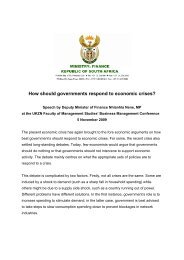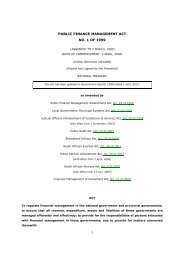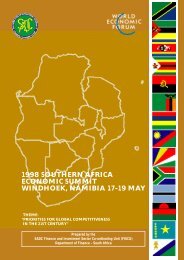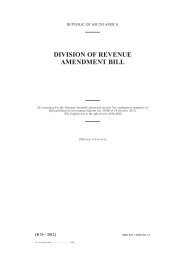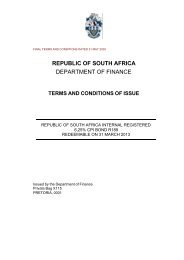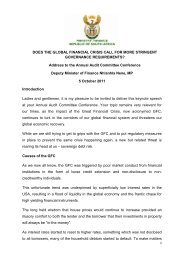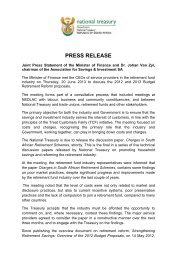Unit Trusts Control Act - National Treasury
Unit Trusts Control Act - National Treasury
Unit Trusts Control Act - National Treasury
You also want an ePaper? Increase the reach of your titles
YUMPU automatically turns print PDFs into web optimized ePapers that Google loves.
Government Gazette<br />
REPUBLIC OF SOUTH AFRICA<br />
Regulation Gazette No. 7218<br />
Vol. 437 Pretoria 30 November 2001 No. 22877<br />
AIDS HELPLINE: 0800-123-22 Prevention is the cure
STAATSKOERANT, 30 NOVEMBER 2001 No. 22877 3<br />
a<br />
GOVERNMENT NOTICE<br />
=<br />
I<br />
:-I -<br />
I<br />
NATIONAL TREASURY<br />
I No. R. 1256 30 November 2001<br />
- NATIONAL TREASURY<br />
I<br />
FINANCIAL SERVICES BOARD<br />
UNIT TRUSTS CONTROL ACT, 1981<br />
FINANCIAL INSTRUMENT REGULATIONS<br />
The Minister of Finance has under section 42, read with section 6(l)(c) of the <strong>Unit</strong> <strong>Trusts</strong><br />
<strong>Control</strong> <strong>Act</strong>, 1981 (<strong>Act</strong> No. 54 of 1981), made the Regulations in the Schedule.<br />
SCHEDULE<br />
1. OEFlNlTlONS<br />
In these Regulations “the Ad‘ means the <strong>Unit</strong> <strong>Trusts</strong> <strong>Control</strong> <strong>Act</strong>, 1981 (<strong>Act</strong> No. 54<br />
of 1981), and any word or expression to which a meaning has been assigned in the<br />
<strong>Act</strong>, shall bear the meaning so assigned to it :<br />
“ASSET PORTFOLIO”, in relation to a unit portfolio, means the portfolio<br />
underlying assets forming the unit portfolio;<br />
of<br />
“CALL OPTION” means an option contract in terms of which the holder of the<br />
contract has the right, but not an obligation, to purchase the relevant underlying asset<br />
or to receive a cash settlement instead thereof;<br />
“CONTRACT SIZE” or “MULTIPLIER”, in relation to a financial instrument, means<br />
the factor by which the price of an underlying asset is multiplied to arrive at the value<br />
of one contract as specified in either -<br />
(i) the rules of the relevant exchange on which the financial instrument is listed;<br />
(ii)<br />
or<br />
the terms and conditions as defined in the offering document of the relevant<br />
instrument;<br />
“DELTA FACTOR”, in relation to a financial instrument, means the requirement for<br />
an exposure calculation for financial instruments as determined in accordance with -<br />
(i) a method prescribed by the relevant exchange for the specific financial<br />
instrument; or<br />
(ii) the terms and conditions as defined in the offering document of the relevant<br />
instrument;<br />
“DELTA SIGN”, in relation to a financial instrument, means the mathematical sign of<br />
the exposure of the financial instrument, determined by the sign of the delta factor,<br />
which can be either positive or negative, determined<br />
accordance with -<br />
0) the delta factor calculation prescribed by the relevant exchange for the<br />
specific financial instrument; or<br />
(ii) the tenns and conditions as defined in the offering document of the relevant<br />
instrument;
4 No. 22877 GOVERNMENT GAZETTE, 30 NOVEMBER 2001<br />
“EXCHANGE”, mean:; a licensed financial exchange as defined in section 1 of the<br />
Financial Markets <strong>Control</strong> <strong>Act</strong>, 1989 (<strong>Act</strong> No. 55 of 1989) or a licensed stock<br />
exchange as defined in section 1 of the Stock Exchanges <strong>Control</strong> <strong>Act</strong>, 1985 (<strong>Act</strong> No.<br />
1 of 1985);<br />
“FINANCIAL INSTRUMENT” means-<br />
(1) an option contract as defined in section 1 of the Financial Markets <strong>Control</strong><br />
<strong>Act</strong>, 1989;<br />
(2) a futures contract as defined in section lof the Financial Markets <strong>Control</strong> <strong>Act</strong>,<br />
1989; or<br />
(3) a warrant, index tracking certificate or instrument, based upon an underlying<br />
asset, declared to be a financial instrument by the Registrar of Financial<br />
Markets under paragraph (d) of the definition of “financial instrument” in<br />
section 1 of thle Financial Markets <strong>Control</strong> <strong>Act</strong>, 1989, and which is listed on<br />
an exchange;<br />
“LIQUID INSTRUMENT”, for the purpose of permitted investment in financial<br />
instruments by unit polrtfolios, means the nominal exposure to liquid instruments as<br />
determined in regulation 6(1) and 6(2);<br />
“NOMINAL EXPOSURE”, in relation to a financial instrument, means the exposure<br />
as calculated in regulation 5(3);<br />
“PUT OPTION” means an option contract in terms of which the holder of the contract<br />
has the right, but not an obligation, to sell the relevant underlying asset or to receive<br />
a cash settlement instead thereof;<br />
”TRANSACTION SIGN”, in relation to a financial instrument, means the transaction<br />
direction, whether buying or selling, of a financial transaction, as calculated in<br />
accordance with regulation b(4);<br />
“UNDERLYING ASSET”, in relation to a financial instrument, means -<br />
(1) any security;<br />
(2) an index as determined by an exchange;<br />
(3) a group of securities which is the subject matter of the financial instrument<br />
whether such group of securities is represented by an index or not; or<br />
(4) in the case of a warrant, option contract or futures contract, any underlying<br />
asset referred to in paragraphs (l), (2) and (3).<br />
2. INCLUSION OF FINANCIAL INSTRUMENTS IN UNIT PORTFOLIO<br />
(1 ) A managemen’t company may include financial instruments in a unit portfolio,<br />
subject to these Regulations and the trust deed and supplemental trust<br />
deeds.<br />
(2) In the application of subregulation (1) a management company may only sell<br />
option contracts which have previously been bought.
STAATSKOERANT, 30 NOVEMBER 2001 No. 22877 5<br />
3. EXPOSURE LIMITS<br />
(1) The sum of the nominal exposures to liquid instruments as a result of the<br />
inclusion of financial instruments in a unit portfolio, together with the market<br />
value of all the physical underlying securities in the unit portfolio, may not<br />
exceed 100 percent of the market value of the unit portfolio, or the nominal<br />
exposulre may not have a value at any time less than that required by section<br />
6(2) of the <strong>Act</strong>.<br />
(2) The nominal exposure to financial instruments on any specific underlying<br />
asset, which is not an index or group of securities, together with the market<br />
value of any physical holding of that specific underlying security, may not<br />
exceed the limitations laid down in section 6(1) of the <strong>Act</strong>.<br />
(3) For the purposes of this regulation, the provisions of subparagraphs (i) and<br />
(ii) of section 6(l)(a) of the <strong>Act</strong> in respect of excesses which are due to<br />
appreciations or depreciations of the market value of the relevant securities,<br />
or an amalgamation, cession, transfer or take-over in terms of section 24 of<br />
the <strong>Act</strong>, apply mutatis mutandis.<br />
4. MAINTAINING; OF CERTAIN ASSETS IN UNIT PORTFOLIO<br />
A management company which in accordance with the provisions of these<br />
Regulations -<br />
sells future contracts, sells call options or call warrants, or buys put options<br />
or put warrants, based on specific underlying assets which are not indices,<br />
shall maintain in the relevant unit portfolio a market value of such underlying<br />
assets with positive nominal exposures to the same underlying assets;<br />
sells futures contracts, sells call options or call warrants, or buys put options<br />
or put warrants, based on index futures or group of securities, shall maintain<br />
an exposure to appropriate underlying assets or other financial instruments<br />
with positive exposures to similar underlying assets, in the relevant unit<br />
portfolio which is at least equal to the nominal exposure of such financial<br />
instrumemts;<br />
buys futures contracts, buys call options or call warrants, or sells put options<br />
or put warrants based on any underlying asset, shall maintain an exposure to<br />
liquid instruments in line with nominal exposure prescribed in regulation<br />
3( 1 );<br />
sells put options or put warrants may maintain a bought put option or bought<br />
put warrant only if the strike price of the bought put options or bought put<br />
warrants are not lower than the sold put option or put warrant in place of<br />
liquid instruments as required in regulation 4(c);
6 No. 22877 GOVERNMENT GAZElTE, 30 NOVEMBER 2001<br />
(e) sells call options or call warrants may maintain a bought call option or bought<br />
call warrant only if the strike price of the bought call options or call warrants<br />
are lower than the sold call option or call warrant in place of underlying<br />
assets as. required in regulation 4(a) or (b);<br />
(f) sells or buys multiple options or multiple warrants based on the same<br />
underlying assets and requiring nominal exposure to liquid instruments per<br />
regulatiorl 4(c), may maintain liquid instruments as needed for only one such<br />
option or warrant transaction; and<br />
(9) sells or lbuys multiple options or multiple warrants based on the same<br />
underlying assets and requiring nominal exposure to underlying assets per<br />
regulation 4(a) or (b), may maintain such instruments as needed for only one<br />
such option or warrant transaction.<br />
5. CALCULATION OF NOMINAL EXPOSURE TO UNDERLYING ASSETS IN UNIT<br />
PORTFOLIO<br />
The exposure of a futures contract or index tracking certificate to an<br />
underlying asset, group of underlying assets or an index shall be calculated<br />
as the prclduct of<br />
(a) The number of contracts.<br />
(b) The relevant contract size.<br />
(c) The current market value of the underlying asset, group of underlying<br />
assets or an index.<br />
The exposure of an option contract or a warrant to an underlying asset,<br />
group of underlying assets, an index or an index future, shall be calculated<br />
as the product of:<br />
(a) The number of option or warrant contracts.<br />
(b) The reilevant contract size.<br />
(c) The current market value of one relevant underlying asset, one group of,<br />
the underlying assets, an index or index future.<br />
(d) The delta factor being one.<br />
The nominal exposure to any financial instrument shall be calculated as the<br />
product of:<br />
(a) The exposure, calculated in accordance with regulation 5(1) or 5(2).<br />
(b) The transaction sign.<br />
The transaction sign is positive for any financial instrument purchased and<br />
negative for any financial instrument sold.<br />
The nominal exposure to financial instruments on any underlying asset is the<br />
sum of the nominal exposure of all financial instruments on the underlying<br />
asset.
STAATSKOERANT, 30 NOVEMBER 2001 No. 22877 7<br />
6. CALCULATION OF NOMINAL EXPOSURE TO LIQUID INSTRUMENTS<br />
ASSOCIATED WITH THE FINANCIAL INSTRUMENTS ON UNDERLYING<br />
ASSETS IN UNIT PORTFOLIO<br />
(1) The nominal exposure to liquid instruments of any financial instrument<br />
required in accordance with regulation 4 shall be calculated as the nominal<br />
exposulre of any financial instrument calculated in accordance with regulation<br />
5(3h<br />
(2) The nominal exposure to liquid instruments for the unit portfolio shall be<br />
calculated as the sum of all the liquid instruments’ nominal exposures<br />
calculated for all financial instruments in the unit portfolio in accordance with<br />
regulation 6( 1 ).<br />
7. REPORT BY ‘THE INDEPENDENT AUDITOR<br />
After the inclusion of a financial instrument in a unit portfolio, and while a financial<br />
instrument remains included in a unit portfolio, a management company shall<br />
furnish the registrar within 30 days after the last business day of each quarter with a<br />
report substantially conforming to Report AI, attached to these Regulations.<br />
8. REPEAL OF REGULATIONS<br />
The Regulaticms published by Government Notice No. R. 2193<br />
Gazette No. lis265 of 19 November 1993, are hereby repealed.<br />
in Government<br />
9. SHORT TITLE AND COMMENCEMENT<br />
These Regulations shall be called the Financial Instrument Regulations, 2001, and<br />
come into operation on 1 December 2001.
8 No. 22877 GOVERNMENT GAZElTE, 30 NOVEMBER 2001<br />
5 REPORT AI<br />
REPORT OF INDEPENDENT AUDITOR OF MANAGEMENT COMPANY IN RESPECT<br />
OF SYSTEM OF INTERNAL CONTROL<br />
........................ (NAME OF UNIT PORTFOLIO),<br />
We have audited the system of internal control regarding<br />
designed to ensure compliance by ............................................ (NAME OF MANAGEMENT COMPANY)<br />
with the Financial Instrument Regulations, 2001 (the Regulations), promulgated under section 42, read<br />
with section 6 (1) ((c), of the <strong>Unit</strong> <strong>Trusts</strong> <strong>Control</strong> <strong>Act</strong>, 1981 (<strong>Act</strong> No. 54 of 1981).<br />
Compliance with tlhe Regulations and the maintenance of an effective system of internal control is the<br />
responsibility of the directors of the management company. Our responsibility is to express an opinion as to<br />
whether or not --<br />
- internal controls were suitably designed to provide reasonable assurance that they would, if operating<br />
as designed, prevent of detect any non-compliance with the Regulations;<br />
- the internal controls operated as designed throughout the quarter ended ...............................<br />
Because of inherent limitations in any system of internal control, errors or irregularities may occur and not<br />
be detected. Also, projections of any evaluation of the internal controls to future periods are subject to the<br />
risk that the systern of internal control may become inadequate because of changes in conditions, or that<br />
the degree of compliance with the policies or procedures may deteriorate.<br />
We conducted our audit in accordance with generally accepted auditing standards. These standards<br />
require that we adlopt procedures to obtain an understanding of the system of internal control designed to<br />
ensure compliance with the Regulations, to evaluate the adequacy of the controls and to test the operating<br />
effectiveness of those controls. We consider that our auditing procedures were appropriate in the<br />
circumstances to express our opinion presented below.<br />
In our opinion -<br />
- the system of: internal control over compliance with the relevant Regulations was suitability designed<br />
to provide reasonable assurance that the controls would, if operating as designed, have prevented or<br />
detected non-compliance with the Regulations;<br />
- the system of' internal control designed to ensure compliance with the Regulations, operated as<br />
designed throughout the quarter ended<br />
..............................................................<br />
.........................................................................................................................................<br />
Without qualifying our opinion above, we draw attention to the following instances of non-compliance with<br />
the Regulations which were/were not subsequently corrected:<br />
Auditor CA (SA)<br />
Address<br />
Date<br />
reg's.derlv's.Ai .sh<br />
Printed by and obtainable from the Government Printer, Bosman Street, Private Bag X85, Pretoria, 0001<br />
Publications: Tel: (01 2) 334-4508, 334-4509, 334-4510<br />
Advertisements: Tel: (012) 334-4673, 334-4674, 334-4504<br />
Subscriptions: Tel: (012) 334-4735, 334-4736, 334-4737<br />
Cape Town Branch: Tel: (021) 465-7531<br />
Gedruk deur en verkrygbaar by die Staatsdrukker, Bosmanstraat, Privaatsak X85. Pretoria, 0001<br />
Publikasies: Tel: (012) 3344508, 334-4509, 334-4510<br />
Advertensies: Tel: (012) 334-4673, 334-4674, 334-4504<br />
Subskripsies: Tel: (012) 334-4735, 334-4736, 334-4737<br />
Kaapstad-tak: Tel: (021) 465-7531<br />
d<br />
22877-1<br />
... yi


